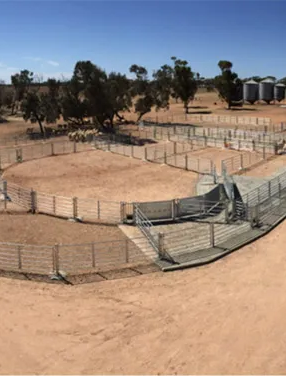Benchmarking Aids Improvement
Increasing lambing percentages was one of the key performance indicator identified by Bert Woolford and his son Dion when benchmarking his sheep enterprise over the past three years.
Bert, his wife Barb, Dion and his wife Chelsea run two properties,”Karawatha” at Buckleboo and “The Soaks” south of Kimba. Their mixed farming enterprise includes Karawatha Park Merino and Poll Merino Stud, 2,000 commercial self-replacing flock and 3 – 3,500 ha of wheat and barley. They also have barley, vetch and Lucerne pastures.
Bert and Dion have been actively involved in the Grain and Graze2 and SheepConnect SA funded Buckleboo Sheep Group since its inception in 2011. Each year members of the group benchmark their sheep enterprise to compare the previous year’s results and identify changes that can be made to improve the operation of the business. Most of the changes Bert and Dion have made to improve their operation are a direct result of being involved in the sheep groups and benchmarking.
“We identified that we needed to improve our lambing percentage” said Bert “We were lambing in autumn and we always had poor feed at that time of year which has meant we spend a lot of time hand feeding to keep the ewes in ideal condition for lambing. We had to really work hard to get 100% lambing.” Bert and Dion set a target of increasing lambing percentage by 10% following the benchmarking session.
“We now lamb in mid-May, and with this year’s excellent start we have marked 120%” said Bert. “We join in December and scan our ewes in March after shearing. This is the first year we have separating the single and twin bearing ewes.” Bert now knows his lambing potential from his flock and manages the twin and single bearing ewes to ensure they have the optimum nutrition at the right time through the pregnancy and lactation.
“We have also changed shearing to every 6 months,” said Bert. “We have been shearings now at 6mths, for 3 years. We program it to fit around all the other operations, like lambing seeding and harvest. We have increased our annual wool cut by at least 1kg. It is never tender and always higher yielding therefore higher price. We are able to get 65 to 70 mm length which doesn’t incur a discount for length whereas at 12 months we were discounted for over 120 mm. We were also able to eliminate crutching. General ease of management is also a big advantage.”
The Woolfords have been using ASBVs when purchasing rams for use in their flock. “We’ve found them to be a really valuable tool for ram selection because they give you confidence when buying a ram that it will deliver the progeny you’re after.”
“The best looking ram doesn’t always breed on the way you hope and that can often be an expensive mistake. By using ASBVs, as well as visual appraisal, it gives us confidence that the ram will deliver the progeny that meet our breeding objectives.”
“We have been collecting information for ASBV’s on our stud merinos for about 2 years and supply a basic range of figures, but now see the benefits of supplying data on ASBV’s for early breech wrinkle and eye muscle depth.” said Bert.
Following this year’s benchmarking Bert would like to increase his stocking rate by 1 DSE to 1.8DSE/WgHa. Reducing capeweed in pastures, applying sulphur and sowing more sheep feed for early fodder production is also on his list to improve his sheep enterprise in the next 12 months. In the past ewes were given two goes to get pregnant then sold. In the future ewes will be given one chance then they are culled said Bert’s son Dion.
Bert, who is a member of the SheepConnect SA Project Advisory Group, said “The benefit of benchmarking with a local group gives us the opportunity to see how we are performing not only from year to year but also within the district. It is a good opportunity to look at yourself and your enterprise, challenge yourself and set some performance goals for the coming years.” “If we can see other people doing well, we know who to bail up and discuss how they do things better or differently,” said Bert.
Author: Bert Woolford - Kimba






